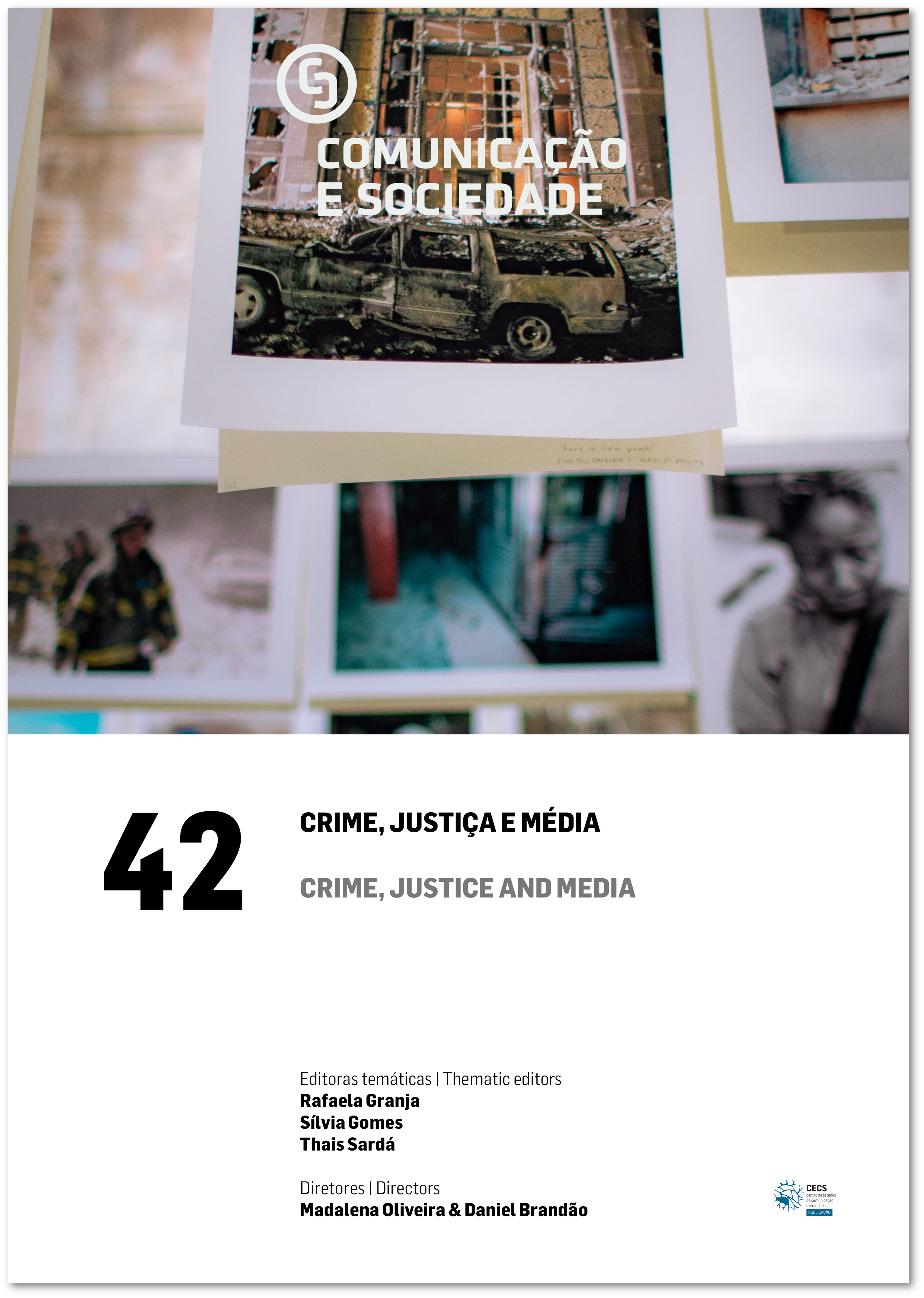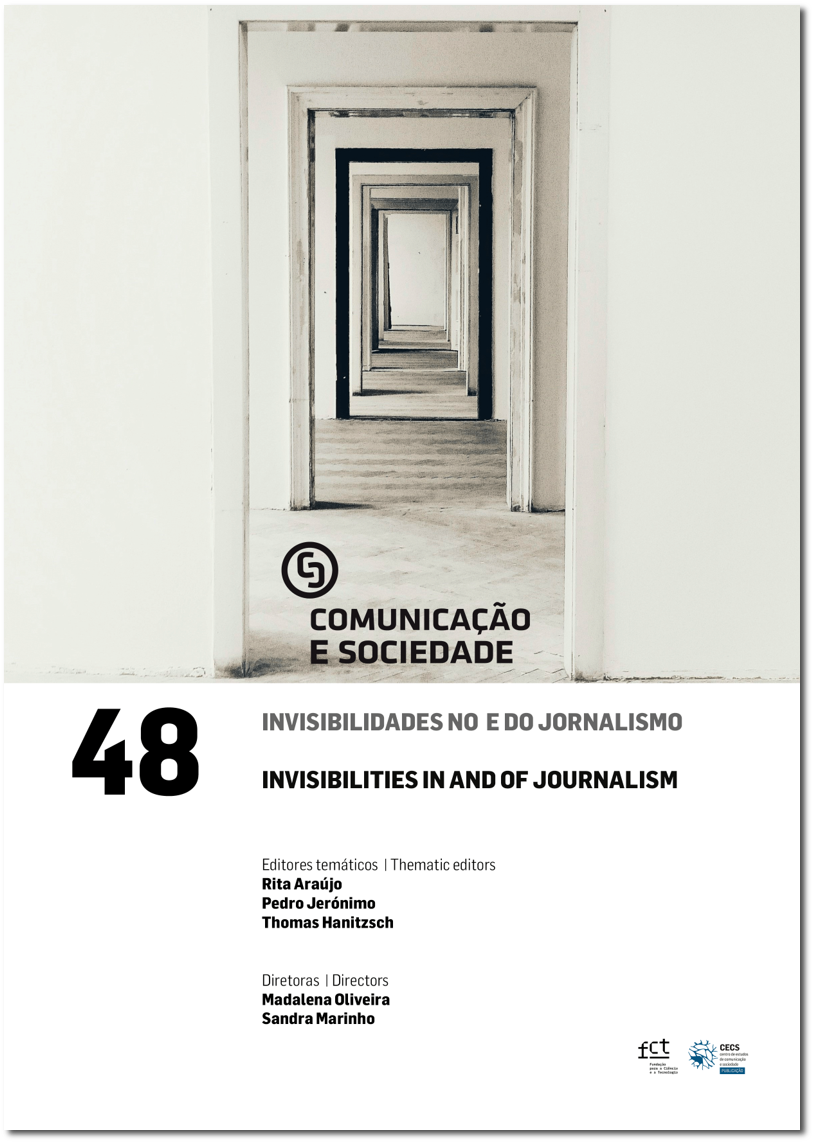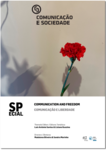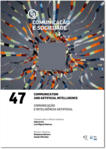Crime, Justice and Media: Debating (Mis)representations and Renewed Challenges
DOI:
https://doi.org/10.17231/comsoc.42(2022).4467Downloads
References
Altheide, D. L. (2009). Moral panic: From sociological concept to public discourse. Crime, Media, Culture, 5(1), 79–99.
Afrouz, R. (2021). The nature, patterns and consequences of technology-facilitated domestic abuse: A scoping review. Trauma, Violence, & Abuse. Advance online publication. https://doi.org/10.1177/15248380211046752
Backe, E. L., Lilleston, P., & McCleary-Sills, J. (2018). Networked individuals, gendered violence: A literature review of cyberviolence. Violence and Gender, 5(3), 135–146. http://doi.org/10.1089/vio.2017.0056
Banks, M. (2005). Spaces of (in)security: Media and fear of crime in a local context. Crime, Media, Culture, 1(2), 169–187. https://doi.org/10.1177/1741659005054020
Berger, P., & Luckmann, T. (2004). A construção social da realidade (2nd ed., F. de S. Fernandes, Trans.). Dinalivro. (Original work published 1966)
Bortner, M. A. (1984). Media images and public attitudes toward crime and justice. In R. Surette (Ed.), Justice and the media: Issues and research (pp. 15–30). Charles C. Thomas.
Bound Alberti, F. (2021). Fat shaming, feminism and Facebook: What ‘women who eat on tubes’ reveal about social media and the boundaries of women’s bodies. European Journal of Cultural Studies, 24(6), 1304–1318. https://doi.org/10.1177/13675494211055499
Brown, S. (2003). Crime and law in media culture. Open University Press.
Brummette, J., DiStaso, M., Vafeiadis, M., & Messner, M. (2018). Read all about it: The politicisation of “fake news” on Twitter. Journalism & Mass Communication Quarterly, 95(2), 497–517. https://doi.org/10.1177/1077699018769906
Brunton, F. (2013). Spam: A shadow history of the internet. The MIT Press.
Button, M., Shepherd, D., Blackbourn, D., Sugiura, L., Kapend, R., & Wang, V. (2022). Assessing the seriousness of cybercrime: The case of computer misuse crime in the United Kingdom and the victims’ perspective. Criminology & Criminal Justice, 1–22. Publicação eletrónica antecipada.
Cádima, F., & Figueiredo, A. (2003). Representações (imagens) dos imigrantes e das minorias étnicas na imprensa. Observatório da Comunicação.
Carvalho, M. (2007). A construção da imagem dos imigrantes e das minorias étnicas pela imprensa portuguesa: Uma análise comparativa de dois jornais diários [Master’s thesis, Instituto Universitário de Lisboa]. Repositório do Iscte – Instituto Universitário de Lisboa. http://hdl.handle.net/10071/675
Castaño-Pulgarín, S. A., Suárez-Betancur, N., Vega, L. M. T., & López, H. M. H. (2021). Internet, social media and online hate speech. Systematic review. Aggression and Violent Behavior, 58, 1–7. https://doi.org/10.1016/j.avb.2021.101608
Chadee, D., & Ditton, J. (2005). Fear of crime and the media: Assessing the lack of relationship. Crime, Media, Culture, 1(3), 322–332. https://doi.org/10.1177/1741659005057644
Chiricos, T., Eschholz, S., & Gertz, M. (1997). Crime, news and fear of crime: Toward an identification of audience effects. Social Problems, 44(3), 342–57. https://doi.org/10.2307/3097181
Cohen, S. (2011). Folk devils and moral panics. Routledge Classics.
Curtis, J., & Oxburgh, G. (2022). Understanding cybercrime in ‘real world’ policing and law enforcement. The Police Journal, 1–20. Advance online publication. https://doi.org/10.1177/0032258X221107584
Cyr, J. (2003). The folk devils reacts: Gangs and moral panic. Criminal Justice Review, 28(1), 25–46. https://doi.org/10.1177/073401680302800103
de Vries, P., & Schinkel, W. (2019). Algorithmic anxiety: Masks and camouflage in artistic imaginaries of facial recognition algorithms. Big Data & Society, 6(1), 1–12. https://doi.org/10.1177/2053951719851532
Dupont, B., & Holt, T. (2022). The human factor of cybercrime. Social Science Computer Review, 40(4), 860–864. https://doi.org/10.1177/08944393211011584
Ericson, R., Baranek, P., & Chan, J. (2010). Research approaches (1987). In C. Greer (Ed.), Crime and media: A reader (pp. 97–107). Routledge.
Ferin-Cunha, I. (2003). Imigração e racismo: Dez anos nos media. http://bocc.ubi.pt/pag/cunha-isabel-ferin-sos-racismo.html
Ferin-Cunha, I., Policarpo, V., Monteiro, T. L., & Figueiras, R. (2007). Media and discrimination: An exploratory study on the Portuguese case. http://bocc.ufp.pt/pag/ferin-isabel-media-and-discrimination.pdf
Ferin-Cunha, I., Santos, C. A., Silveirinha, M. J., & Peixinho, A. T. (2008). Media, imigração e minorias étnicas – 2005-2006. Alto Comissariado para a Imigração e Diálogo Intercultural.
Floridi, L. (2014). The fourth revolution. Oxford University Press.
Garland, D. (2008). On the concept of moral panic. Crime, Media, Culture, 4(1), 9–30. https://doi.org/10.1177/1741659007087270
Gomes, S. (2013). Criminalidade, etnicidade e desigualdades – Análise comparativa entre os grupos nacionais dos PALOP e leste europeu e o grupo étnico cigano [Doctoral dissertation, Universidade do Minho]. RepositóriUM. https://hdl.handle.net/1822/25413
Gomes, S. (2015). Media e crime. Dos media e da construção das realidades criminais. In M. I. Cunha (Ed.), Do crime e do castigo – Temas e debates contemporâneos (pp. 81–97). Editora Mundos Socias.
Goode, E., & Ben-Yehuda, N. (1994). Moral panics: The social construction of deviance. Blackwell.
Greenwald, G. (2014). No place to hide: Edward Snowden, the NSA & the surveillance state. Penguin Books.
Greer, C. (2012). Sex crime and the media: Sex offending and the press in a divided society. Routledge.
Greer, C. (2013). Crime and media: Understanding the connections. In C. Hale, K. Hayward, A. Wahadin, & E. Wincup (Eds.), Criminology (3rd ed., pp. 143–164). Oxford University Press.
Guibentif, P. (2002). Comunicação social e representação do crime. Gabinete de Estudos Jurídico-Sociais do CEJ.
Hall, S., Critcher, C., Jefferson, T., Clarke, J., & Roberts, B. (1978). Policing the crisis: Mugging, the state, and law and order. Palgrave Macmillan.
Haney, C., & Manzolati, J. (1981). Television criminology: Network illusions of criminal justice realities. In E. Aronson (Ed.), Readings about the social animal (pp. 125–136). Freeman.
Hans, V., & Dee, J. (2010). Cobertura mediática da justiça: O impacto nos jurados e no público. In H. Machado & F. Santos (Eds.), Justiça, ambientes mediáticos e ordem social (pp. 39–56). Húmus.
Hayward, K., & Yar, M. (2006). The “chav” phenomenon: Consumption, media and the construction of a new underclass. Crime, Media, Culture, 2(1), 9–28. https://doi.org/10.1177/1741659006061708
Hickman, M. (1982). Crime in the streets — A moral panic: Understanding “get tough” policies in the criminal justice system. American Journal of Criminal Justice, 7(1), 7–22. https://doi.org/10.1007/BF03373788
Hoang, N. P., & Pishva, D. (2014, February 16–19). Anonymous communication and its importance in social networking [Conference presentation]. The 16th IEEE International Conference on Advanced Communication Technology, Pyeongchang, South Korea. https://doi.org/10.1109/ICACT.2014.6778917
Hunt, A. (1997). Moral panic and moral language in the media. The British Journal of Sociology, 48(4), 629–648. https://doi.org/10.2307/591600
Jardine, E. (2018). Tor, what is it good for? Political repression and the use of online anonymity-granting technologies. New Media & Society, 20(2), 435–452. https://doi.org/10.1177/1461444816639976
Jewkes, Y. (2004). Media & crime. Key approaches to criminology. Sage Publications.
Karstedt, S. (2010). Emoções e direito penal. In H. Machado & F. Santos (Ed.), Justiça, ambientes mediáticos e ordem social (pp. 17–38). Edições Húmus.
Katz, J. (1987). What makes crime “news”? Media, Culture & Society, 9, 47–75. https://doi.org/10.1177/016344387009001004
Laidler, K. J., Lee, M., & Wong, G. P. (2017). Doing criminology on media and crime in Asia. Crime, Media, Culture, 13(2), 135–151. https://doi.org/10.1177/1741659017710296
Landau, S. (2017). Listening in: Cybersecurity in an insecure age. Yale University Press.
Larsson, S., Svensson, M., & Kaminski, M. de. (2012). Online piracy, anonymity and social change: Innovation through deviance. Convergence, 19(1), 95–114. https://doi.org/10.1177/1354856512456789
Lippmann, W. (1922). Public opinion. The Free Press.
Luhmann, N. (1196). The reality of the mass media. Stanford University Press.
Machado, H., & Santos, F. (2008). Crime, drama e entretenimento: O caso Maddie e a meta-justiça popular na imprensa portuguesa. Oficina do CES, 310, 1–32. https://ces.uc.pt/pt/publicacoes/outras-publicacoes-e-colecoes/oficina-do-ces/numeros/oficina-310
Machado, H., & Santos, F. (2009a). Dramatização da justiça e mediatização da criminalidade: Que rumos para o exercício da cidadania? Configurações, (5/6), 55–74. https://doi.org/10.4000/configuracoes.374
Machado, H., & Santos, F. (2009b). A moral da justiça e a moral dos media: Julgamentos mediáticos e dramas públicos. Oficina do CES, 333, 1–18. http://hdl.handle.net/10316/32674
Malbreil, X. (2007). About the internet imaginary and its evolution. Texto Digital, 3(1), 1–41. https://doi.org/10.5007/%25x
Manovich, L. (2002). The language of new media. The MIT Press.
Martin, J. (2014). Lost on the Silk Road: Online drug distribution and the ‘cryptomarket’. Criminology & Criminal Justice, 14(3), 351–367. https://doi.org/10.1177/1748895813505234
McCombs, M. (2002). The agenda-setting role of the mass media in the shaping of public opinion [Unpublished manuscript]. https://www.infoamerica.org/documentos_pdf/mccombs01.pdf
McGregor, S. C. (2019). Social media as public opinion: How journalists use social media to represent public opinion. Journalism, 20(8), 1070–1086. https://doi.org/10.1177/1464884919845458
McLeod, P. L. (2011). Effects of anonymity and social comparison of rewards on computer-mediated group brainstorming. Small Group Research, 42(4), 475–503. https://doi.org/10.1177/1046496410397381
Mendes, J. M. (2004). Media, públicos e cidadania: Algumas notas breves. Revista Crítica de Ciências Sociais, (70), 147–158. https://doi.org/10.4000/rccs.1054
Mills, J., Gomes, S., & Walzak, J. (in press). The press has gone crazy: Online media and political rhetoric of immigrants in the US. International Journal of Migration and Border Studies. https://.doi.org/10.1504/IJMBS.2022.10048342
Morselli, C., Décary-Hétu, D., Paquet-Clouston, M., & Aldridge, J. (2017). Conflict management in illicit drug cryptomarkets. International Criminal Justice Review, 27(4), 237–254. https://doi.org/10.1177/1057567717709498
Mosco, V. (2004). The digital sublime. The MIT Press.
Müller, K., & Schwarz, C. (2020). Fanning the flames of hate: Social media and hate crime. SSRN. https://doi.org/10.2139/ssrn.3082972
Orgad, S. (2012). Media representation and the global imagination. Polity Press.
Oz, M., Zheng, P., & Chen, G. M. (2018). Twitter versus Facebook: Comparing incivility, impoliteness, and deliberative attributes. New Media & Society, 20(9), 3400–3419. https://doi.org/10.1177/1461444817749516
Peelo, M. (2006). Framing homicide narratives in newspapers: Mediated witness and the construction of virtual victimhood. Crime, Media, Culture, 2(2), 159–175. https://doi.org/10.1177/1741659006065404
Penedo, C. (2003). O crime nos media: O que nos dizem as notícias quando nos falam de crime. Livros Horizonte.
Pina, S. (2009). Media e leis penais. Edições Almedina.
Ramos, F., & Novo, H. (2008). Mídia, violência e alteridade: Um estudo de caso. Estudos de Psicologia, 8(3), 491–497. https://doi.org/10.1590/S1413-294X2003000300016
Rego, X. (2015). Da insegurança de rua. Notas sobre um objeto complexo. In M. I. Cunha (Ed.), Do crime e do castigo – Temas e debates contemporâneos (pp. 63–80). Editora Mundos Socias.
Reiner, R. (2007). Media made criminality: The representation of crime in the mass media. In M. Maguire, R. Morgan, & R. Reiner (Eds.), The Oxford handbook of criminology (pp. 302–337). Oxford.
Robinson, M. B. (2018). Media coverage of crime and criminal justice (3rd ed.). Carolina Academic Press.
Sacco, V. (1995). Media constructions of crime. The Annals of the American Academy of Political and Social Science, 539, 141–154. https://doi.org/10.1177/0002716295539001011
Santos, C. (2008). Imagem da imigração e minorias étnicas nos media. In A. Fidalgo, F. Ramos, J. P. de Oliveira, & O. Mealha (Eds.), Livro de actas: 4º Congresso da Associação Portuguesa de Ciências da Comunicação (pp. 967–975). Sopcom.
Santos, F. (2009). Jornalistas e magistrados: Perspectivas cruzadas nas relações entre os media e a justiça [Master’s thesis, Universidade do Minho].
Scolari, C. A. (2009). Mapping conversations about new media: The theoretical field of digital communication. New Media & Society, 11(6), 943–964. https://doi.org/10.1177/1461444809336513
Sharon, T., & John, N. A. (2018). Unpacking (the) secret: Anonymous social media and the impossibility of networked anonymity. New Media & Society, 20(11), 4177–4194. https://doi.org/10.1177/1461444818768547
Sparks, R. (2001). The media, populism, public opinion and crime. Criminal Justice Matters, 43, 6–7. https://www.crimeandjustice.org.uk/publications/cjm/article/media-populism-public-opinion-and-crime
Striphas, T. (2015). Algorithmic culture. European Journal of Cultural Studies, 18(4–5), 395–412. https://doi.org/10.1177/1367549415577392
Surette, R. (1998). Media, crime and criminal justice. Wadsworth.
Thukral, P., & Kainya, V. (2022). How social media influence crimes. Indian Journal of Law and Legal Research, 4(2), 1–11. https://doi-ds.org/doilink/04.2022-64941518/IJLLR/V4/I2/A18
van Dijck, J. (2013). The culture of connectivity: A critical history of social media. Oxford University Press.
van Hardeveld, G. J., Webber, C., & O’Hara, K. (2017). Deviating from the cybercriminal script: Exploring tools of anonymity (mis)used by carders on cryptomarkets. American Behavioral Scientist, 61(11), 1244–1266. https://doi.org/10.1177/0002764217734271
Vargo, C. J., Guo, L., & Amazeen, M. A. (2018). The agenda-setting power of fake news: A big data analysis of the online media landscape from 2014 to 2016. New Media & Society, 20(5), 2028–2049. https://doi.org/10.1177/1461444817712086
Wacquant, L. (2000). The new “peculiar institution”: On the prison as surrogate ghetto. Theoretical Criminology, 4(3), 377–389. https://doi.org/10.1177/1362480600004003007
Webster, C. (2001). Representing race and crime. Criminal Justice Matters, (43), 16–17.
Williams, M. L., Burnap, P., Javed, A., Liu, H., & Ozalp, S. (2020). Hate in the machine: Anti-Black and anti-Muslim social media posts as predictors of offline racially and religiously aggravated crime. The British Journal of Criminology, 60(1), 93–117. https://doi.org/10.1093/bjc/azz049
Wu, T.-Y., & Atkin, D. J. (2018). To comment or not to comment: Examining the influences of anonymity and social support on one’s willingness to express in online news discussions. New Media & Society, 20(12), 4512–4532. https://doi.org/10.1177/1461444818776629
Downloads
Published
How to Cite
Issue
Section
License
Copyright (c) 2022 Sílvia Gomes, Thaís Sardá, Rafaela Granja

This work is licensed under a Creative Commons Attribution 4.0 International License.
Authors own the copyright, providing the journal with the right of first publication. The work is licensed under a Creative Commons Attribution 4.0 International License.











